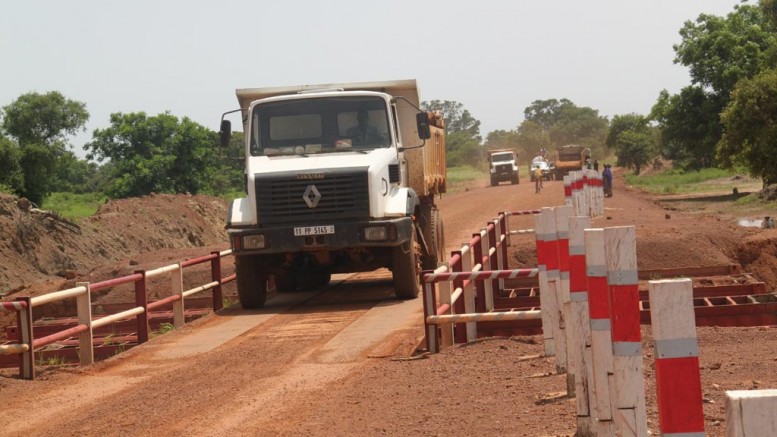VANCOUVER — Shares of Orezone Gold (TSXV: ORE; US-OTC: ORZCF) were pummelled after the company revealed that its flagship Bomboré project in Burkina Faso, West Africa, contains much less gold than previously reported. On Aug. 22, the company said that “preliminary results” show a 30% decline in global reserves and resources.
The revelation abruptly halted the positive momentum Orezone had been building over the past few months. The company received its mining permit on Aug. 12, and said it aimed to start construction during the second quarter of 2017. Orezone also completed a $26.5-million equity financing in July, wherein it issued 26.5 million shares to a syndicate of underwriters co-led by Raymond James and National Bank.

Drillers at work on the Bomboré site in 2013. Credit: Orezone Gold.
The company was forced to withdraw a series of technical documents including a 2015 feasibility study; 2014 preliminary economic assessment; and the suspect resource estimate, which was released in mid-2013.
The major culprit appears to be different modelling techniques by two engineering firms. The calculations were done three years ago by SRK Consulting, while the newer technical work is being led by Roscoe Postle Associates.
Though Orezone cites the exclusion of “environmentally sensitive areas” and “two small satellite deposits set aside for artisanal miners,” it appears that more conservative methods are the main cause for the drop in in-situ gold ounces.

Employees log core at the Bomboré site in 2013. Credit: Orezone Gold.
The company states that the “previous estimate had no boundary between the low grade and the waste domains, while the 2016 model has no grade modelling within the waste domain, and limits the grade modelling within a low-grade domain.”
Bomboré’s 2013 resource estimate was 140 million tonnes grading 1.01 grams gold per tonne for 4.6 million oz. across all “ore” types. The technical document underpinned the feasibility study based on oxide and transitional reserves of 60 million tonnes grading 0.76 gram gold for 1.47 million contained oz. gold.
Orezone’s previous plan envisioned a two-staged build that would begin with a hybrid heap-leach, carbon-in-leach operation. The initial mining phase would have produced 135,000 oz. gold annually over an eight-year life at all-in sustaining costs of US$678 per ounce. Capital expenses for the first phase were pegged at US$250 million.
“Given our recent permitting success with the project, this news is an unfortunate setback. However, it does not diminish our enthusiasm and commitment to building a mine at Bomboré,” Orezone president and CEO Ron Little said in the news release. Management did not respond to a request for comment by press time.
Orezone says its updated resource should be ready by early September.

The Bomboré camp at sunset. Credit: Orezone Gold.
The company intends to revise and release feasibility economics for initial production as soon as possible “to determine the next stage of development for the project.”
The company’s shares dropped 50%, or 61¢ per share, on nearly 7 million shares traded after the news. Orezone has traded within a 52-week range of 22¢ to $1.28, and last closed at 60¢ per share. The company has 154 million shares outstanding for a $65-million market capitalization.
In response to the news, BMO Capital Markets analyst Andrew Breichmanas dropped his target price on Orezone from $1.75 per share to 75¢ per share. BMO Research also lowered its estimate of “mineable resources” from 1.5 million oz. gold to 1 million oz. gold.
“We recently had taken a constructive view on the stock based on feasibility study economics, the potential for the project to advance towards production after receiving permits and the upside through further evaluation of the sulphide resources,” Breichmanas writes. “However, the likely negative resource update appears to place the viability of the project in question until the feasibility study is revised.”
Canaccord Genuity analyst Eric Zaunscherb cut his price target from $1.60 per share to $1.10 per share. He notes, however, that Bomboré’s “average grade is not expected to change,” and kept his “speculative buy” rating on the stock.


Be the first to comment on "Orezone takes a beating after bumbled Bomboré resource"